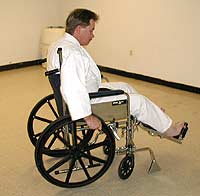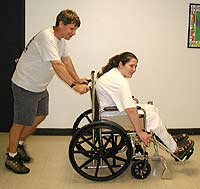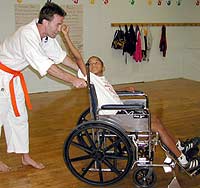Kurumaisu Jutsu:
Wheelchair Techniques
Part 1- The Fast Push From Behind
By Ronald van de Sandt

Editor's Note:
Part one of this article discusses one common attack against someone seated
in a wheelchair: the push from behind. Part
Two will discuss a frontal attack.
Looking at someone in a wheelchair is a world of difference from actually
being confined to one. This seems like an obvious statement, but few realize
how true it is. It was my good fortune a while back to test the truthfulness
of this statement by actually becoming a "wheeler" myself, even
though it was for a relatively short period. Yes, I said "good fortune";
for what I learned from the experience changed my martial arts life forever
by opening up a deeper understanding of the ancient martial arts, as well
as an appreciation for those who are handicapped.
I realized early on that some "attacks" are unique to those
in wheelchairs, such as someone sneaking up from behind, then suddenly
pushing you and your chair very fast.
Some "attacks" though, are common to both the wheelchair bound
as well as people who are sitting in a chair, on a bench or on a train
or subway or on the floor. I also learned some of the principles of movement
I used also reflected those of aikido, and that many of the movements
came right out of many of the karate kata I had practiced for so long.
The Wheelchair
Before describing various defenses we have to examine the wheelchair
and its parts, which serve as our rolling weapon.  Certain
parts of a wheelchair can be very effective martial devices, especially
when combined with normal grappling and throwing techniques. Certain
parts of a wheelchair can be very effective martial devices, especially
when combined with normal grappling and throwing techniques.
The back wheels are large, rubberized, and have a slightly smaller wheel
at the center, usually made of steel. These big rear wheels also have
lever type brakes designed to stop the wheels in order to keep the chair
from rolling. The wheelers hands control the smaller inner wheel to maneuver
the chair. The smaller wheels protect the hands from the rubberized portion,
which is in constant contact with the ground.
The wheelchair rolls easily and smoothly, can turn in a tight circle,
and move forward and backward. If you push one wheel and pull on the other
hard, you can develop a very quick 360-degree spin in place. The turning
radius of a typical chair is about a five-foot diameter circle, and the
space should be considered the same as a normal martial artist's Kazushi
circle (personal space).
A typical chair will have armrests on either side, steel footrests that
are at ankle height, and a pair of handles in the back, normally used
for mobility (pushing) assistance. The front wheels or casters are usually
very small compared to the back wheels. One of the disadvantages of a
wheelchair that became evident very quickly is that when you punch, the
chair seemed to roll in the opposite direction if the wheels were not
locked, unless you retrieved your punch very quickly. Another disadvantage
is that if the wheelchair is tipped over, most of the chair's advantages
disappear.
This article addresses wheelchair techniques, but assumes for brevity
that the wheelchair person has fairly normal use of their body from the
waist up, and that the wheelchair is of standard hospital issue type with
foot rests.
Modifications to these two assumptions may require the technique to be
modified accordingly.
Attack Scenario 1: The fast push from behind
 Sometimes
this attack comes from friends trying to be funny, and sometimes it comes
instead from someone who is just plain mean, trying to intimidate the
person in the wheelchair. Either way, to come from behind someone in a
wheelchair and push him or her at a run unexpectedly is not usually funny
to those in confined to a wheelchair. In fact, it usually gives them the
feeling of helplessness, unless they know what to do. This however, is
one of the most common "attacks" to the wheelchair bound. Here
are a couple of techniques that can be used to stop it. Sometimes
this attack comes from friends trying to be funny, and sometimes it comes
instead from someone who is just plain mean, trying to intimidate the
person in the wheelchair. Either way, to come from behind someone in a
wheelchair and push him or her at a run unexpectedly is not usually funny
to those in confined to a wheelchair. In fact, it usually gives them the
feeling of helplessness, unless they know what to do. This however, is
one of the most common "attacks" to the wheelchair bound. Here
are a couple of techniques that can be used to stop it.
Defense Technique 1 - The Jab
Remember the wheel locks mentioned above? Use them! Simply lock them
down as quickly as you can. These locks are usually designed so that if
you are rolling, they will slow you down. The chair will not just suddenly
stop, but will stop.
If your chair locks the wheels quickly but without tipping the chair,
many times the opponent will get jabbed by the wheelchair's push handles
and the opponents' own forward momentum.  The
brakes will make it very difficult for someone to continue pushing for
very long, and will usually embarrass the friend who is trying to be funny. The
brakes will make it very difficult for someone to continue pushing for
very long, and will usually embarrass the friend who is trying to be funny.
Before doing this technique though, with a friend or family member you
trust, try the technique carefully to see how your particular chair reacts,
and adjust the technique accordingly. Although unlikely, you do not want
to suddenly apply the brakes and find out the chair locks the wheels so
quickly that you fall out of the chair from the forward momentum. Anti-tip
devises are also available for most wheelchairs.
Defense Technique 2- The Pivot
A second, more aggressive technique may also need a little practice first,
and possibly the brakes adjusted for greater pressure to make it work.
As the perpetrator begins to push you fast, grab and hold the inner wheel
on one side very tight, or apply the lock on only one of the wheels while
simultaneously pushing forward on the other wheel for extra momentum.
Hold on; because if done correctly, and with the right chair, it is possible
to very quickly spin 360 degrees on the axis of the locked wheel.
This is a very aikido-like technique. You are pivoting to the outside
of the force directed at you from behind. In the process you get to the
outside of the attacker.
This will usually take the opponent off guard, often causing them to
lose balance, even if it does not spin the full 360 degrees. If spun quick
and far enough, the footrests of the chair may also come around and catch
the opponent on the ankles. Either way, the opponent will usually think
twice before trying that attack again, and it may also be very embarrassing
for them.
I was amazed at the stability of my chair when I first performed this
technique. But all chairs are not the same, so again, experiment first
with someone you trust.
Defense Technique 3 - Back Strike And Throw
| A third, even more aggressive move that may be
used is to twist in your seat with a right back-fist to the assailant's
face. This defense isn't limited to just wheelchair defense. It
can equally be used by someone sitting on a chair or a bench to
defend against a variety of attacks from behind. The only difference
is that in a wheelchair you might be rolling from the push. |
 |
After you execute a backfist immediately slip your right arm underneath
the attackers right armpit and lever him forward and to the right, which
should throw him to the floor.
For those in a wheelchair this can work with or without locking both
of the wheels, depending on the stability of your chair. Locking the wheels
provides more stability, but not locking them makes a quicker technique.
If he doesn't want to go (be thrown), getting the push-handle in the
crotch generally provides the needed extra encouragement. If you are not
in a wheelchair a quick backwards elbow to the groin will have the same
effect. Follow up with a face punch or just roll the chair over a convenient
limb. It must be practiced to work, and it must be done quickly. Experiment
with several variations. This technique is derived from kata Kusanku.
About The Author:
Ron van de Sandt has been in the martial arts since 1972 and has studied
American Kempo, Shorin Kempo and Sholin Karate - a blend of Shorinji
Ryu and Shorin Ryu Karate. Mr. van de Sandt currently holds a Dan rank
in Sholin Karate, and runs the Sholin Karate Club, at the Fairborn YMCA,
Fairborn, Ohio.
|